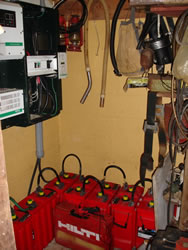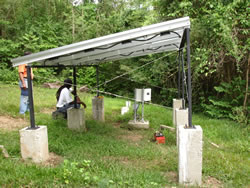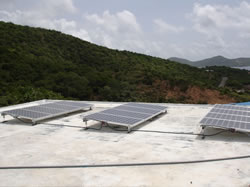
|
|
October 2006 |
FSEC Works with Virgin Islands on PV System Quality Program In 1999, the U.S. Virgin Islands Energy Office (VIEO) contracted with FSEC to establish a program to ensure that photovoltaic systems met quality standards. FSEC’s Kevin Lynn recently visited the islands to conduct a detailed analysis of eight systems that have been installed as part of this program, and his report provides an interesting look at the types of projects that are suitable for remote locations. "When the U.S. Virgin Islands Energy Office decided to implement a solar energy program,” he explained, “they asked us to implement quality measures to ensure that only high-quality systems were installed and approved. One of these quality measures consisted of a technical specification as part of a request for quotations (RFQ), so Jim Dunlop wrote an RFQ for photovoltaic systems that represented a minimum requirement for system installers to meet in order to participate in the VIEO program” (the RFQ can be read at http:/www.fsec.ucf.edu/pvt/VIEO/index.htm).
Lynn explained that after the RFQ was distributed, a number of contractors applied for the program, sent their designs to FSEC for review, and then installed the approved systems. In February 2005, Dunlop went to the Virgin Islands to perform acceptance tests on these new systems. He found several problems that needed to be addressed and gave the VIEO a report on them. Earlier this year, VIEO contacted FSEC again to perform a second round of acceptance tests. Based on the specifications and the reports from the first visit, Lynn performed this second round of acceptance tests in June on eight PV systems located on the islands of St. Croix, St. Thomas, and St. John to determine if the systems met the requirements of the specification. Two types of PV systems were tested. Seven of the eight systems were nominally 1- or 2- kilowatt PV systems with an inverter, battery bank, and critical load center. These power systems are capable of operation in either stand-alone mode or interconnected in parallel with the utility supplied electrical service to the facility. The inverter/charger is designed specifically for operation with battery subsystems. Pending approval by the utility, systems may be interconnected with the utility grid at a later date.
As configured initially, the inverter/charger and battery system will be connected to the grid for battery charging purposes and load consumption only and will not feed excess energy back into the utility grid. Under normal circumstances, the inverter sub panel loads will be powered directly from the battery subsystem and inverter, which is recharged from either the PV array or utility grid. In the event the battery becomes discharged below the specified limit, the inverter will transfer the loads connected to the inverter sub panel to utility power, and the battery bank will start being recharged. Once the battery has been recharged to a pre-determined limit, the system will again power the sub panel loads from the inverter/battery system. The other PV system was a PV water pumping system. The specification required this type of system be mobile and consist of a direct-current (dc) pump-motor, a photovoltaic array, wiring and controls, trailer and support structure, and other required balance of system components. The following table shows the systems that were recently inspected:
The reporting method on all eight of the systems is not completely uniform. Since two of the systems, Mt. Victory and Bamboula Haven, were already inspected and reported on during Dunlop’s visit, the information on these two systems was generally limited to the points he brought up in 2005. For the other six systems, no information on these was available before Lynn’s inspections. As a result, an attempt was made to compare the system installation to the requirements found in the specification within the time allotted for each inspection.
“Working with the Virgin Islands Energy Office was a great experience,” Lynn noted. “Not only is it a beautiful location, but this work represented a great opportunity for FSEC to help the USVI make photovoltaics a more accepted technology for everyone, including government agencies and the utility. While there are always growing pains when introducing a new technology, I was very impressed with the level of work and effort put into this project by both the Energy Office and the contractors involved. Two of the sites, Bamboula Haven and John Folly, are community centers, so they are perfect locations to demonstrate the technology. As a result of this project, it is my hope that the Water and Power Authority (WAPA) will agree to a simple and straightforward interconnection standard for all photovoltaic systems.” You can view a copy of the complete report on each system with detailed specifications at http://www.fsec.ucf.edu/pvt/VIEO/index.htm. |


